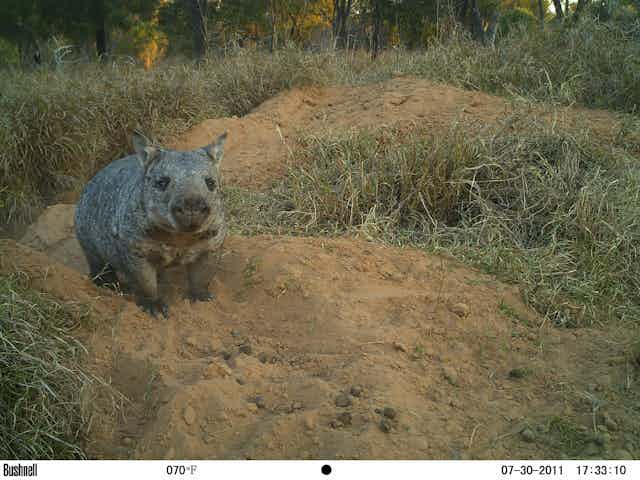Bringing a species back from the brink of extinction is never easy. Typically, it takes long-term commitment, amounting to lifetimes of hard work by dedicated scientists, managers and supporters.
That is especially true if the species is a big animal with a low breeding rate, because such species respond slowly to our efforts. No species of Australian wildlife better illustrates these points than the Northern Hairy-nosed Wombat.
The Northern Hairy-nosed Wombat (Lasiorhinus krefftii) is the largest of Australia’s three wombat species: females can weigh over 40 kg.
It is distinguished from the Southern Hairy-nosed Wombat by its broad muzzle and black eye-rings as well as large size, and from the Common Wombat by its silky grey fur, long ears and (of course) hairy nose.
Status
Early in the 20th century it was thought that the Northern Hairy-nosed wombat was extinct, after the disappearance of the only two populations then known (one near St George in southern Queensland, the other near Jerilderie in New South Wales). Then, in the 1930s, a small population was discovered in what is now Epping Forest National Park in central Queensland. This population was in decline, and by 1982 there may have been only 30 or so animals left.
In that year cattle were removed to protect the wombat’s habitat. Monitoring the population to find out if this caused an increase in numbers was difficult. Northern Hairy-nosed Wombats are not only nocturnal, they are extremely shy, and therefore difficult to observe. A capture and release program in the late 1980s and early 1990s suggested a population size of about 63.
That study also showed that trapping to this extent caused significant disruption to the wombats, so a better census method was found. This involved collecting hairs on sticky tape at burrow entrances, and amplifying DNA to identify the individual wombats.
In 2000, the Northern Hairy-nosed Wombat became the first species to be censused from remotely collected genetic samples. The estimated population size was 113.
The latest census in 2010 found 163 wombats. This is still a very small number, but it represents as much as a fourfold increase in the population since its habitat was protected.

Monitoring the population suggests that the increase has been intermittent. The wombats live in a dry tropical environment, where most rain falls in an unreliable summer wet season. Several good wet seasons in succession may be needed for females to breed and for their young to survive to weaning.
It might be only in periods like the last few years, with three excellent wet seasons in a row, that the population increases. Evidence from remote cameras and footprints suggests that many young have been born recently.
Threats
Past declines were probably caused by competition for pasture from cattle and sheep, especially during drought. Northern Hairy-nosed Wombats never venture far from their burrows to feed. When overgrazing removes all pasture from around their burrows, they starve.
Though the Epping Forest population is slowly increasing, the wombats are in a precarious position. While all of the world’s Northern Hairy-nosed Wombats live in just one place the species’ ultimate extinction is almost inevitable. This is because sooner or later some local catastrophe – a drought, flood, fire, disease epidemic, or something unforeseen – will strike and wipe the population out.
Strategy
Because episodes of successful breeding can be rare, a high survival rate of adults is essential: breeding females need to live through the bad years so that they can take advantage of the good ones. Management of the Epping Forest population therefore aims to protect adult survival.
In 2000-2001 dingoes invaded the Park and killed at least nine wombats. In response, a predator-proof fence was built around the wombats’ habitat. Feeding and drinking stations have been provided to support the population in lean times (although most of the wombats don’t use them).
The other goal of management is to establish populations elsewhere. The search for a suitable place for a second population began about 20 years ago. A good site, now known as the Richard Underwood Nature Refuge, was eventually found and, happily, made available by the landholders. It was prepared by de-stocking, fencing, and digging artificial burrows.
The first animals were transferred from Epping Forest in 2009. So far 15 have been moved there. They have settled well, and breeding was confirmed in March 2011.
Unsurprisingly, there have been setbacks. Some animals died of unknown causes, and while three young have been born so far, only one survives. But all nine animals currently living there are in good condition and the population should grow.
Conclusion
With the Epping Forest population increasing, and a second population becoming established at the Richard Underwood reserve, the Northern Hairy-nosed Wombat seems on the road to recovery. The Richard Underwood refuge is small (only 130 hectares) and the search is now on for a place to establish a third and larger population.
When that is done, we might be able to say that, after many decades of hard work, the northern hairy-nosed wombat is safe from extinction at last.
This article was written with help from Dr Alan Horsup, who leads the Northern Hairy-nosed Wombat recovery project in the Queensland Department of Environment and Heritage Protection.
The Conversation is running a series on Australian endangered species. See it here.

